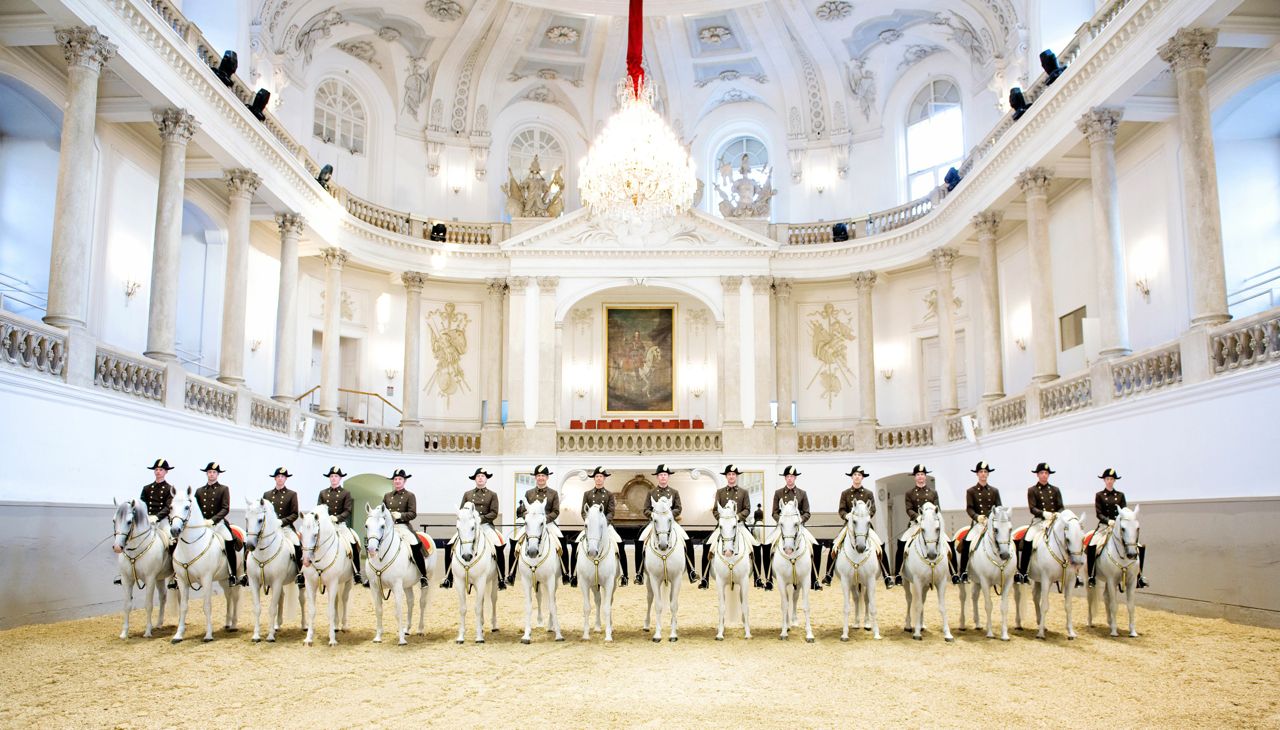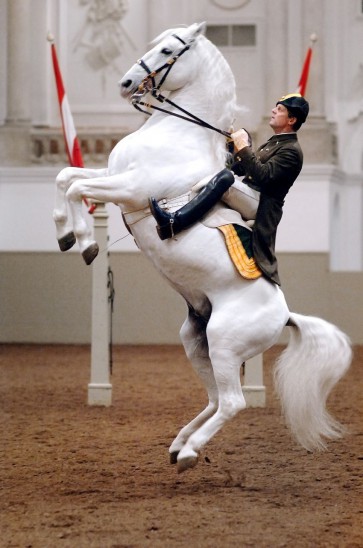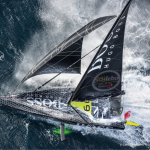
The Spanish Riding School has lived through wars and fires and, miraculously, survived them all. As the legendary school celebrated its 450th anniversary we travelled to Vienna to experience a mythic place.
By Camilla Alfthan, all photos courtesy of The Spanish Riding School
IT IS IN THE HEART of Vienna that the highest form of classical riding takes place in the baroque building of Hofburg underneath the finely chiseled ceilings with crystal chandeliers. Here, riders still bow in front of an oil painting of their former Emperour who founded the capital’s traditions for music and theatre. A passionate horse lover, Karl VI continued his predecessor’s popular horse ballets – Rossballetten – which were also a fashion at the Italian courts.
The horses were the same, light-footed Lipizzaners that we know today – stallions who are born dark brown and raised in the mountains of Piber, as they gradually go from dappled grey to snowy white as they grow older and learn to master the most demanding exercises.
Contrary to what one might think; the most expressive of them all were originally created for war fare. When the horse reared from the ground in a levade it shielded its rider from frontal attacks. In a capriole – where the horse flies high above the ground with all four legs in the air – it created extra space when the rider was surrounded by foot soldiers.
When two noble men met in a fight they approached one another in several leaping courbettes.
For the past centuries, the exercises have been a testament of Austria’s illustrious history performed as a horse ballet to classical music. The Spanish Riding School is not only the oldest riding academy in the world – it is also the only place where the high school of classic horsemanship has been cherished and maintained for over 430 years.
As an important part of Austria’s cultural heritage the school receives thousands of guests for its weekly performances.
One of the reasons for its huge popularity is that it has survived countless ordeals – from having it’s buildings destroyed during the war against the Turks to surviving earthquakes and fires during which the horses were evacuated as Austria’s most treasured works of art.
The latest dramatic rescue took place during the Second World War and towards its end, it was General Patton who assured the survival of the academy at a time when its role was purely connected with a cultural pride.
HISTORY AND HERITAGE
Nowadays, the Lipizzaners only travel when they’re on tour to perform in front of large audiences.
One of its riders is Herwig Radnetter, 54, who grew up in the eastern part of Austria near the Hungarian border. Horses were always a part of his life. His family were saddlemakers and his grandfather was in the cavalry. His father rode horses and when he was seven or eight, Radnetter saw the Spanish Riding School perform for the very first time.
“I knew I wanted to do the same. It was simply beautiful. It opened up a way of working, riding and making a living with horses,” he smiles.
Aged 15 Radnetter left his family to become a part of the historic school. Today, he has specialized in doing the levade in the saddle and on a short hand rein.
“First we learn all the exercises and then we specialize,” he tells.”We each have seven or eight horses to train so it’s important to have a good mixture of young, medium and fully trained horses that we can use for the presentations.”
“If a horse doesn’t want to do a levade or a capriole there’s no way you can force it.”
Work is rigorous and begins at seven o’clock every morning. As the Lippizaner is a little slower in maturing than other breeds the horses are started at the age of four. They live longer than most horses and the oldest performing stallions are around 25. They’re not as big as other breeds which means that the riders can’t be any taller than around six foot.
Their gaits are also a little bit higher than in traditional dressage horses which is why they are rarely seen in international competitions.
The exercises of the Spanish Riding School, however, go beyond any classical dressage programme and the horses thrive on it.
“If a horse doesn’t want to do a levade or a capriole there’s no way you can force it to do so. That’s why it is so important that we train them honestly and carefully. We totally depend on them,” says Radnetter.
While the Lipizzaners originated from the Lipizza stud in Trieste during the time of the Austrian Empire they are now bred in the Austrian Alps in Piber where there are currently around 250 horses and foals.
“The place is beautiful – the horses grow up in 1,600 meters of altitude and that is a part of the reason why they are so strong. There are few injuries in their legs because they’re out in the mountains all day long,” tells Radnetter who trains the stallions in the same way as generations have before him.
When they come down from the mountains at age four, they are lounged and learn to get used to the rider’s weight. They walk, trot and canter and afterwards; there’s the selection of the horses that are assigned to the different riders. From here on they stay with the same rider until they retire. Radnetter’s personal favourite is Conversano Tiberia.
“Our bond with the horses is very strong. Just consider how much time we spend with them – about 20 years with the same stallions six days a week. So it becomes a very strong relationship. They are a part of our lives.”
Riders in the Hofburg, photo © Stefan Seelig
“In the beginning we all start the horses from scratch. Then as you get older you don’t have to sit on a fresh horse anylonger. But you’re responsible for your horses and you make decisions for the training,” tells Radnetter.
When they’re on tour it is the mutual understanding between rider and horse that keep the performances smooth.
“They’re so well trained and they know us so well that they don’t mind travelling and showing in different arenas. Sometimes the first performance is a little different because the sounds of the audience are different. The arenas can be very loud and people sit closer so the horses pay more attention to them and that’s a challenge. They’re living animals and every performance is a challenge. If they make mistakes they are minor and people don’t notice them. “
“The horses definitely know when they have been doing something right. When we do the shorthand rein we treat them right after they succeded with the exercise. When we sit on them we pat them and they just know.”
Currently, the oldest rider at the academy is 65. As for Herwig Radnetter, he hopes to keep riding for as long as possible.
“When you bring a young horse into a performance for the very first time and you find out how the training went…that’s the moment when you have to prove everything that you give. If it was good or not. If it was good it is always a highlight.
Every horse who does a good job and who enjoys it is a highlight. Riding in in front of big crowds are highlights.
My best time of the day is when a horse went well and when he learned something new.”
A Levade by Herwig Radnetter, photo © Michael Rzepa
Unforgettable!
QUESTIONS FOR THE CAPRIOLEUR
Herbert Seiberl
Why did you chose to specialize in this field?
“That was a coincidence. The first horse I started to train by hand was very able in this particular section and so I stayed with it. That horse was Siglavy Theodora II.”
How do you make a capriole – what are the technical steps?
“We start by teaching the horse the Piaffe from the ground, followed by letting it kick out on demand, also without a rider on its back. Once the horse understands this, it has to learn the same with the forehand following a certain gesture or touch. When the horse is finally able to do both at once, the change from doing it by hand to doing it with a rider is easy. Here, you first let the horse perform the Piaffe and out of that it carries out the jump on command. Some react to the click of the tongue, others, like my horse for example, react to a command by the hand.
You have to try several ways to find out what works best; the horse usually shows you the easiest way.”
How long does it take to learn ? And how many tries until you succed?
“Depending on the horse it takes 3 to 6 years to learn.
Horses are animated beings with a free will and not machines; even horses that have already completed their training don’t always do what we want them to. It takes a countless number of tries, a strong relationship between horse and rider, patience, affection and – above all – treats, to make an exercise work.”
What was your feeling the first time you tried it ?
“Unforgettable.”
THE ACADEMY
The first horses were described in Austrian literature in 1550 as having roamed at a “Rosstummelplatz” on the current St. Joseph place. Later, Emperour Leopold I launched the colourful riding carrousels where horses would perform to music. Wars ravaged the riding hall and in 1729 Karl VI decided to build the Hofburg Palace as a symbol of Austria’s victories and imperial power.
In 1895 it was decided that the beautiful building, with ceilings that rise 17 meters above the ground, should only be used for horses. The existing directives which describe the purpose of the school were written by Oberretiter Johann Meixner and Feldmarshall Franz Holbein von Holbeinsberg.
A minimum of eight riders are needed for a performance. In 1925 the School performed for the first time outside the borders of Austria with a show in Berlin, and in 1927 it travelled to London and Aachen, which helped make it world famous. Training however ceased during the Second World War and did not begin until 1955 when the Lipizzaners were finally brought back to their home in Vienna where they have remained ever since. While only stallions perform for practical reasons, the school opened up for women riders in 2008.
THE LIPIZZANERS
The horses originated from the Iberian Peninsula during the 16th century as a cross between Spanish, Arabian and Berber horses which were later bred at the Lipizza stud in Trieste. There are six burn marks that symbolize their founding fathers – waves for Pluto, a stallion born in 1765 in Denmark; a country surrounded by the sea. A Neapolitan sword lowered in a greeting for Neapolitano and an arrow for Siglavy symbolizing the stallion’s Arabic origins. A crown for Maestoso and a Neapolitan coats of arm for Conversano where the first stallion came from Napoli. A square for Favory – the stallion from the Kladruber stud farm.
From the beginning the horses were not only selected by their exteriours but also by their interiours. One for its gallantness another for its intelligence. Some come from a family of caprioleurs – an exercise which demands a great deal of temperament. Others will instinctively rear – those, with a talent for levades or courbettes.
THE MUSIC
The music was always an important part of the Spanish Riding School and performances would not be the same without it. From the eight young stallions who open the show to Riedinger’s Festive Entrance – to Mozart’s Symphony No. 40 in G minor which is played during the Pas de Deux where two stallions perform a Piaff in synchronized harmony as mirror images.
Boccherini’s delicate menuet accompanies the Work by the hand which prepares the horse for the most difficult exercises. The impresssive Capriole is performed with Johan Strauss’ imposing Wienerblut.
For the final quadrille, the choreograhy is in perfect harmony with the works of Chopin, Bizet and Riedinger.
While the music helps the horses and the riders perform, it also helps the audience to understand and fully appreciate the exercises. When the riders exit the stage to the festive sound of Prince Eugen’s March they are the living images of a bygone era which has been preserved as Austria’s most precious jewel.
Riders below the painting of Emperour Karl VI who continued the traditions of the Academy and built the Hofburg in the heart of Vienna.
The 450th celebrations take place at Hofburg in July and will feature the show, Piber Meets Vienna, quadrilles of 12 horses and the impressive Imperial Fête with ballet performances. For more information go to www.srs.at © Stefan Seelig
Unvergesslich!
Warum haben Sie sich entschieden in der Kapriole spezializiert?
“Das war ein reiner Zufall. Das erste Pferd, mit dem ich selbst begonnen habe, Handarbeit zu praktizieren, hat sich dafür besonders geeignet – und so bin ich dann dabei ‚hängen‘ geblieben. Das war Siglavy Theodora II.”
Wie lässt sich eine Kapriole zu machen – was sind die technischen Schritte?
“Begonnen wird mit dem Erlernen der Piaffe an der Hand, aus der heraus wird das Streichen (Ausschlagen nach hinten) ebenfalls an der Hand probiert, hat das Pferd diese Lektionen verstanden, versucht man es vorne wegstreichen zu lassen und es letztendlich auf eine Berührung anzulernen, die es dazu bringen, beides gleichzeitig zu tun. Wenn das Pferd sich dazu eignet, dann ist der Umstieg auf Sitzen auf dem Pferd leicht. Hier piaffiert man das Pferd zunächst und daraus entwickelt sich der Sprung auf Kommando bzw. Berührung. Manche springen auf Zugenschnalzen, meiner z.B. reagiert auf meine Hand. Es ergibt sich aus einer Spielerei mit dem Pferd heraus, worauf es reagiert; das Pferd zeigt einem schon, wie es am einfachsten ist.”
Wie lange hat es gedauert um zu lernen? Und wie viele versucht haben Sie zu machen, bis Sie Erfolg?
“Je nach Pferd zwischen 3 und 6 Jahre. Pferde sind Lebewesen und keine Maschinen, selbst ausgebildete Pferde machen nicht immer, was man will. Es stecken unzählige Versuche dahinter, eine starke Beziehung zwischen Pferd und Reiter und viel Geduld und Zuneigung und natürlich auch Belohnungen.”
Wie haben Sie das Gefühl zum ersten Mal ausprobiert?
“Unvergesslich.”
©




